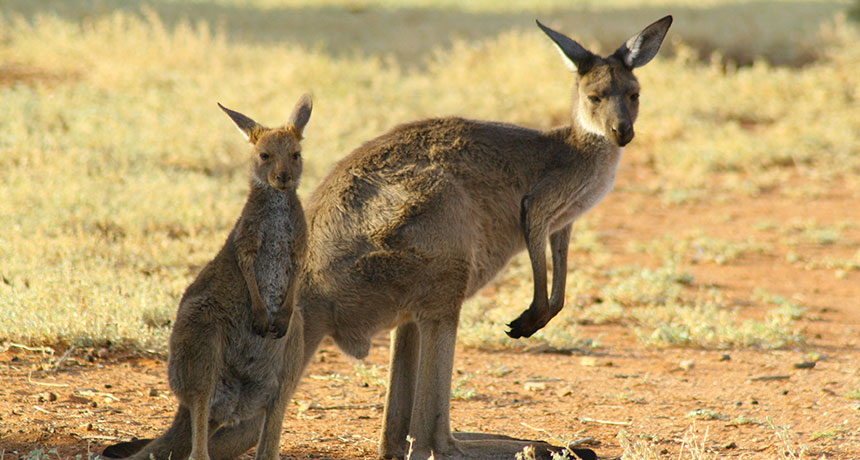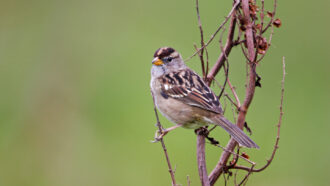Kangaroo farts: Not so ‘green’ after all?
The amount of methane they emit may be linked to how fast food moves through their guts

Kangaroos like this western gray release methane, a greenhouse gas, in their farts. But if food moves quickly through their guts, those methane emissions may stay low — much lower than had been expected.
ADAM MUNN
Okay, here’s an indelicate observation. Like many animals, kangaroos fart. And when they do, that gas emerges spiked with methane.
More methane is escaping the behinds of kangaroos than earlier research had suggested. That’s the conclusion of researchers in a new study. It was published online November 4 in the Journal of Experimental Biology.
Methane is a greenhouse gas. Like carbon dioxide, it contributes to global warming. Animals can produce methane. It comes out in farts and burps. Knowing how that gas is produced in ‘roos might one day help farmers curb the amount of gas emitted by livestock, such as cattle.Kangaroo toots had been considered easy on the environment because they had been thought to contain little to no methane. But a new study shows that may not be true. It was led by Adam Munn, a wildlife biologist at the University of Wollongong in Australia. Munn and his colleagues show that a kangaroo can produce nearly 1,000 liters (260 gallons) of methane per year.
That doesn’t make kangaroos a major source of this greenhouse gas. Cows can let out between 250 and 500 liters a day. But despite being smaller than cows, eacg ‘roo can spew two to four times as much of the worrisome greenhouse gas.
The bottom line, Munn says: “What we found is that kangaroo’s methane is low, but it’s not as low as some studies have suggested.”
Gut germs on the go
Munn’s team studied western gray kangaroos (Macropus fuliginosus) and red kangaroos (Macropus rufus). They fed the animals the same diets of alfalfa hay for 12 days. At the start, the kangaroos were put on a restricted diet. They got slightly less than they usually eat. Then the researchers let the kangaroos eat as much as they wanted.
On the restricted diet, both species of kangaroos produced more methane than when they ate the free-rein diet. That could be because a higher intake moves food and microbes through the digestive tract faster. And that might give the gut microbes who live there too little time to establish a steady population and make plenty of methane.
When “food moves through the gut more slowly, it’s giving the bacteria more time to go from a growth phase to a maintenance phase of the life cycle,” says Munn. It’s that maintenance phase that produces methane, he says.
Not everyone agrees, though.
The researchers failed to determine the mix of all microbe species in the kangaroos’ guts, notes Athol Klieve. He is a microbiologist at the University of Queensland in Australia. A team that included Klieve reported last year that the particular mix of microbes in kangaroo guts is responsible for the roos’ low-methane emissions. Klieve isn’t sure how Munn and his colleagues could draw conclusions about methane production without looking at the activity of those methane-producing germs.
He says there also are issues with studying animals in captivity. Those in the new study ate a different diet than they would eat in the wild. So Klieve questions how normal the gut-microbe communities were in those ‘roos. In contrast to the new study, he says, “There are heaps of other papers that show that very little methane is produced.”
Power Words
(for more about Power Words, click here)
bacterium (plural bacteria) A single-celled organism. These dwell nearly everywhere on Earth, from the bottom of the sea to inside animals.
biology The study of living things. The scientists who study them are known as biologists.
carbon dioxide A colorless, odorless gas produced by all animals when the oxygen they inhale reacts with the carbon-rich foods that they’ve eaten. Carbon dioxide also is released when organic matter (including fossil fuels like oil or gas) is burned. Carbon dioxide acts as a greenhouse gas, trapping heat in Earth’s atmosphere. Plants convert carbon dioxide into oxygen during photosynthesis, the process they use to make their own food. The abbreviation for carbon dioxide is CO2.
fart One of the oldest words in the English language, it refers to flatulence (or flatus) — the release of gas from the end of the digestive tract.
greenhouse gas A gas that contributes to the greenhouse effect by absorbing heat. Carbon dioxide is one example of a greenhouse gas.
methane A hydrocarbon with the chemical formula CH4 (meaning there are four hydrogen atoms bound to one carbon atom). It’s a natural constituent of what’s known as natural gas. It’s also emitted by decomposing plant material in wetlands and is belched out by cows and other ruminant livestock. From a climate perspective, methane is 20 times more potent than carbon dioxide is in trapping heat in Earth’s atmosphere, making it a very important greenhouse gas.
microbe Short for microorganism. A living thing that is too small to see with the unaided eye, including bacteria, some fungi and many other organisms such as amoebas. Most consist of a single cell.
microbiology The study of microorganisms, principally bacteria, fungi and viruses. Scientists who study microbes and the infections they can cause or ways that they can interact with their environment are known as microbiologists.







